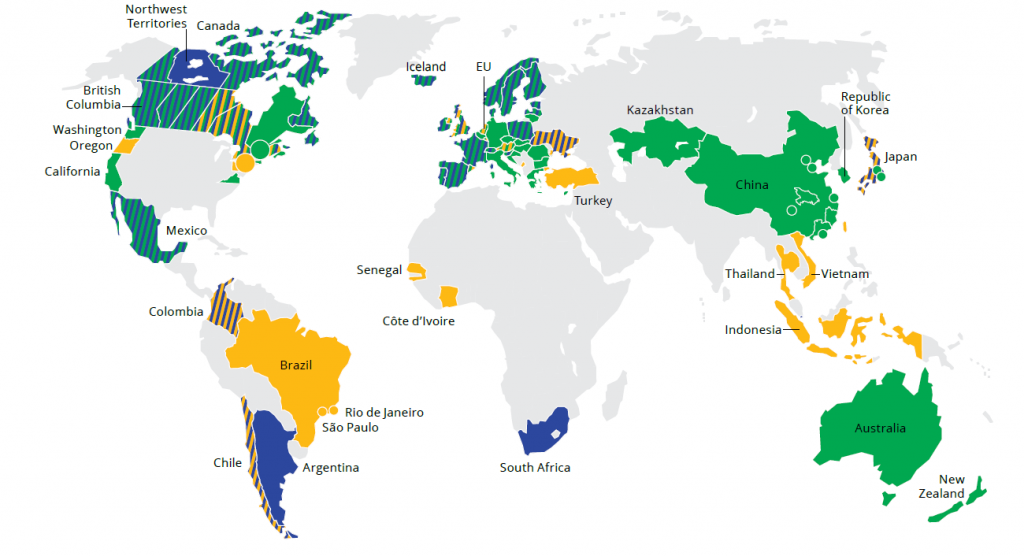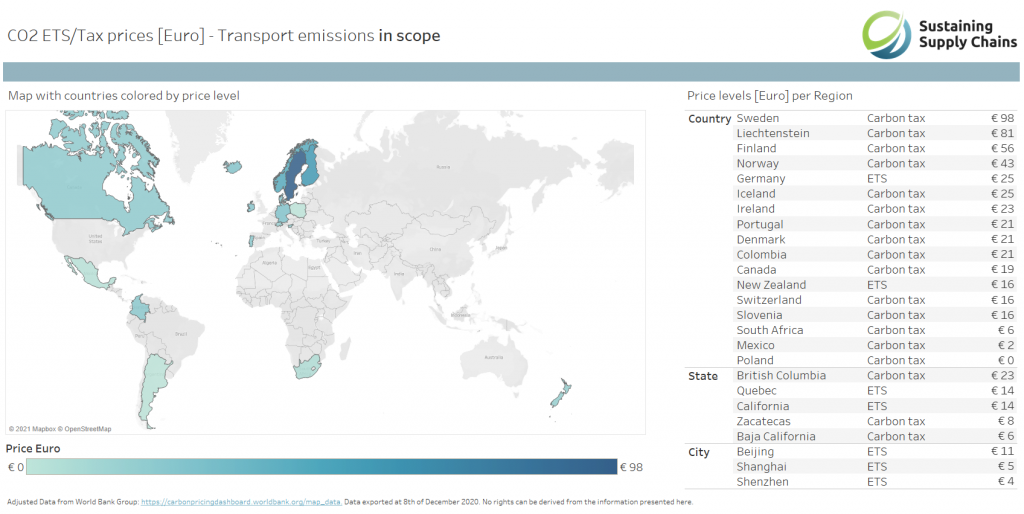In its Green Deal, the European Union plans to broaden the scope of the current Emission Trading System (ETS). Transport emissions will be incorporated into the ETS scope. Germany starts with carbon pricing within transport since the beginning of this year. What can we expect as effects of these (upcoming) decisions? How will this influence the Supply Chain in the coming period?
What is carbon pricing?
Carbon pricing is not a new concept. Finland and Poland already introduced carbon pricing in 1990. However, over the past years the number of carbon pricing initiatives has increased. Moreover, the scope of activities subjected to carbon pricing broadened over the last years. Finally, the pricing of carbon emissions is increasing for most initiatives.
In general, two types of carbon pricing systems are used. At the one hand there are Emission Trading Systems and at the other hand you have the CO2 taxes. The ETS works with a gap on the total emissions allowed and let the market determine the price for the emission of a ton CO2e. CO2 taxes have a fixed price for emitting a ton CO2e. Both systems have pro’s and con’s, that is probably why they are both used. However, in general you could say that it is more difficult to set the right level of allowed CO2e emissions (ETS) than setting the right tax price [1].
The map below shows the current carbon pricing initiatives with their geographical scope (last update August 2020) [2].


Transport scope
Not all carbon pricing initiatives have emissions from transport included in their scope, e.g. the current European Union ETS includes the industry and power sectors only. Considering the 64 already implemented and scheduled initiatives, 33 of them have emissions in scope originating from transport (i.e. transport of goods by road). For 25 initiatives with transport emissions in scope, the current pricing is shown in the figure below. Pricing varies from €98 to €0.1 per ton emitted CO2.

For most initiatives, the importer or distributor of fuels is responsible for paying the CO2 tax/ETS permits. Hence, the fuel price is subjected to the carbon price level. For example, the Finland CO2 tax price level increases the price of diesel with approximately 10 eurocents.
British Columbia
The Carbon tax of British Columbia (Canada) is an example that has been successful considering CO2 emission reduction. Between 2008 and 2013 a CO2 emission reduction of 17.4% per capita was realised [3]. A few success factors are considered. At first, the scope is relatively broad, covering 70% of the total emissions. More important is that the tax incomes were used to realize a tax reduction for households. Also, subsidies were financed by the carbon tax incomes for initiatives resulting in CO2 emission reduction. However, over the last years CO2 emissions have increased back again to the 2007 levels.
Economists say that price levels should be in the range of 40 – 80 USD (33 – 65 Euro) in 2020 to be effective and realize emission reductions [4]. One of the reasons for the British Columbia CO2 tax being less effective is the price level of $28 (€23), being under the suggested bandwidth.
Germany
Germany now starts with a carbon tax, including transport, from 2021 onwards. The tax price level starts at €25, increasing to €55 per ton CO2 in 2025. Based upon the Carbon pricing report [4] suggested price levels, serious effects may be expected from the German tax. From a logistic perspective, costs will increase due to higher fuel prices (5 – 10 eurocents increase). Hence, realizing less CO2 emissions becomes for transport in Germany necessary, also from an economic perspective.
Consider a simple an example of shipping a FTL (20 ton pay weight) from Bonn to Wolfsburg (375km). This shipment results in an approximate emission of 0.825 ton CO2e. In 2021 this will lead to an extra €20 transport costs. Depending on your current rates this results in a tariff increase of 2.5 – 4.5 % for transport in Germany, which is significant.
Conclusion
Different systems are used for pricing CO2 emissions. There are many differences in scope, pricing mechanisms and pricing levels between the different initiatives. Resulting in different effects. Illustrated by the successful effects in the past of the carbon tax in British Columbia. By implementing a carbon price, including transport, Germany starts challenging the current emissions of road transport from a financial perspective. Transport costs will increase for Germany, making sustainable supply chain choices becoming more and more relevant. Since the EU is planning to do the same, we expect this urgency only to increase.
Do you want to know more about CO2 pricing and the effects for your company’s supply chain? Or are you interested in the opportunities for your company to reduce CO2 emissions? Contact us at info@sustainingsupplychains.com . We are ready to help you!
Sources:
[1] Ervaringen met CO2-beprijzing: zeven lessen; Rabobank/RaboResearch; Karolina Ryszka; March 2020
[2] State and Trends of Carbon Pricing 2020; World Bank Group; Washington DC; May 2020
[3] BC’s Carbon tax shift after five years: Results – An Environmental (and Economic) Success Story; Dr. Stewart Elgie, Jessica Mcclay; Sustainable Prosperity; July 2013
[4] Report of the High-Level Commission on Carbon Prices; Carbon Pricing Leadership Coalition; World Bank; May 2017
Assumptions:
- To convert Euro to US Dollar or vice versa, 1 EURO = 1.22 USD is used as conversion factor
- For the emission calculation a truck with an emission of 110 gram CO2e per tonkm and 20 ton payload is assumed




